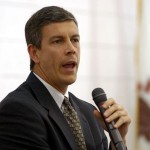
The president of the country’s for-profit college association said school officials have “severe concerns” about an Education Department (ED) report that showed 5 percent of for-profits are in danger of losing access to federal student aid.
For-profit colleges, which have some of the country’s most expansive online learning programs, that have not met any of the federal government’s three “gainful employment” requirements would be cut off from federal aid, which accounts for as much as 90 percent of for-profit schools’ annual profit.
Losing aid would force many colleges or universities to shut down, higher-education officials said.
Steve Gunderson, president of the Association of Private Sector Colleges and Universities (APSCU) and a former Republican congressman, said for-profit college administrators have raised doubts about the validity of the latest federal numbers.
“In some instances, schools have not received the rates for all of the programs for which they submitted information, and in others, not all of the metric information was readily available,” Gunderson said, who called the set of government rules an “incredibly complicated and defective program.”
Colleges must meet only one of three federal metrics: At least 35 percent of former students are repaying their loans, the annual loan payment of a typical graduate doesn’t exceed 30 percent of his or her discretionary income, and the annual loan payment isn’t more than 12 percent of the student’s yearly earnings.
Thirty-five percent of for-profit programs meet all three federal requirements. Three in 10 meet one of the requirements.
“Career colleges have a responsibility to prepare people for jobs at a price they can afford,” said ED Secretary Arne Duncan. “Schools that cannot meet these very reasonable standards are on notice: invest in your students’ success, or taxpayers can no longer invest in you.”
Gunderson, repeating an argument from the fierce legislative battle over gainful employment rules in 2010, said ED’s statistics don’t account for the for-profit industry’s disproportional number of low-income students.
“The Department of Education’s gainful employment regulation has an unfortunate history using erroneous metrics regarding student demographics and repayment rates,” he said.
The ED report examined more than 3,600 programs at 1,300 colleges over the past two years.
The 5 percent of schools that did not meet any of the federal requirements consisted of 193 programs in 93 colleges, according to ED’s report.
The statistics have drawn the scrutiny of state officials across the country. Fifteen state Attorneys General have launched formal investigations into for-profit colleges’ allegedly predatory recruitment of military veterans.
If enforced, the government’s gainful employment rules would build a barrier to higher education for nontraditional students, Gunderson said.
“This burdensome regulation, if implemented as currently construed, will deny access for hundreds of thousands of Americans such as working parents, veterans and other … students who have oftentimes taken a different path when seeking and obtaining their postsecondary education,” he said.
President George W. Bush, a supporter of for-profit schools, said in an address to the APSCU’s national convention in June that colleges that receive federal money should be regulated.
“Any time you reform, it sparks controversy…. My attitude all along is that you’ve got to measure…. If government spends money, doesn’t it make sense for government to ask, are there results? I think it does,” Bush said, according to Republic Report, a blog that tracks for-profit regulations.
Bush was greeted by silence, according to Republic Report.
- Research: Social media has negative impact on academic performance - April 2, 2020
- Number 1: Social media has negative impact on academic performance - December 31, 2014
- 6 reasons campus networks must change - September 30, 2014
